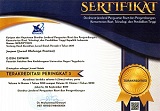Hubungan Fleksibilitas dan Kekuatan Terhadap Kemampuan Tendangan Dollyo Chagi Atlet Taekwondo Universitas Negeri Yogyakarta
DOI:
https://doi.org/10.21831/jorpres.v17i2.40569Keywords:
Olahraga, Taekwondo, HubunganAbstract
Olahraga merupakan aktivitas fisik yang tidak bisa lepas dari aktivitas manusia. Olahraga terbagi menjadi olahraga pendidikan, olahraga rekreasi, dan olahraga prestasi. Salah satu Cabang olahraga yang masuk dalam olahraga prestasi adalah cabang olahraga taekwondo. Taekwondo merupakan cabang olahraga yang berasal dari negara Korea. Pertandingan di cabang olahraga taekwondo terbagi menjadi kategori kyorugi (Pertarungan) dan Poamse (Seni)., Penelitian ini bertujuan untuk mengetahui : hubungan antara variabel fleksibilitas dan kekuatan terhadap kemampuan tendangan dollyo chagi. Penelitian ini menggunakan metode diskriptif dengan teknik analisis korelasional. Populasi penelitian ini adalah anggota unit kegiatan mahasiswa taekwondo Universitas Negeri Yogyakarta., Hasil penelitian menunjukan bahwa variabel fleksibilitas diperoleh nilai korelasi sebesar 0.709 memiliki hubungan dengan kemampuan tendangan dollyo chagi secara signifikan, variabel kekuatan memperoleh nilai korelasi sebesar 0.449 memiliki hubungan dengan kemampuan tendangan dollyo chagi dan tidak siginifikan. variabel fleksibilitas dan kekuatan diperoleh nilai korelasi sebesar 0.732 memiliki hubungan dengan kemampuan tendangan dollyo chagi secara signifikan.
The Relationship of Flexibility and Strength to Dollyo Chagi Taekwondo Athletes of Yogyakarta State University
Abstract
Exercise will be physical activity that can not be separated from human activity. Sports are divided into educational sports, recreational sports, and achievement sports. One of the sports that enter the sport of achievement is the sport of taekwondo. Taekwondo is a sport originating from Korea. Training in taekwondo sports is divided into kyorugi (Fighting) and Poamse (Art) zones. This study is used to determine the relationship between variable and strength forces in which power is sized or more than dollyo chagi. This study uses discrete correlational analysis techniques. The study was a member of the taekwondo student activity unit of Yogyakarta State University. The results of the study point that the variable correlation value of 0.709 has a relationship with the condition that dollyo chagi is important, the variable strength of correlation value of 0.449 has a relationship with the condition dollyo chagi and not significant. The variable aeration and strength of the correlation value of 0.732 have a relationship with a good way of beading.
References
Ahn, J. D., Hong, S. ho, & Park, Y. K. (2009). The Historical and Cultural Identity of Taekwondo as a Traditional Korean Martial Art. The International Journal of the History of Sport, 26(11), 1716–1734. https://doi.org/10.1080/09523360903132956
Bompa, T. (1999). Periodization, Theory and Methodology of Training. Iowa: Kendall Hunt Publishing
Company.
Bridge, C. A., Jones, M. A., & Drust, B. (2011). The activity profile in internationaltaekwondo competition is modulated by weight category. InternationalJournal of Sports Physiology and Performance, 6(3), 344–357.https://doi.org/10.1123/ijspp.6.3.344
í‡atıkkaÅŸ, F. (2003). Elit taekwondocularda mí¼sabaka puan etkinlikleri ile kanlaktat iliÅŸkisinin incelenmesi [Examination of the relationship between blood lactate elite taekwondo athletes in competition activity score].Yí¼ksek Lisans Tezi, Ege íœniversitesi SaÄŸlık Bilimleri Enstití¼sí¼, Ä°zmir.
Dikdik zafar Sidik & Paulus Pesurnay (2019). Pelatihan Kondisi Fisik. Bandung: Remaja Rosdakarya
Del Vecchio, F. B., Franchini, E., Del Vecchio, A. H. M., & Pieter, W. (2011). Energy absorbed by electronic body protectors from kicks in a taekwondo competition.Biology of Sport,28 (1), 75-78.
Giriwijoyo Santoso. 2010. Ilmu Faal Olahraga (Fungsi Tubuh Manusia Pada Olahraga Untuk Kesehatan dan untuk Prestasi).Bandung: Remaja Rosdakarya
Harsono. (1988) Coaching dan aspek-aspek psikologis dalam coaching. Jakarta.C.V. Tambak Kusuma
Lakes, K. D., Bryars, T., Sirisinahal, S., Salim, N., Arastoo, S., Emmerson, N.,Kang, D., Shim, L., Wong, D., & Kang, C. J. (2013). The Healthy for Life Taekwondo pilot study: A preliminary evaluation of effects on executive function and BMI, feasibility, and acceptability. Mental Health and Physical Activity, 6(3), 181–188. https://doi.org/10.1016/j.mhpa.2013.07.002
Lewis P. (1996). The martial arts, Biddles Ltd., Guildford and Kings Lynn.
Mailapali, D.R et. al (2015) Bhiomechanics of the taekwondo axe kick. India:Indian Institute of Technology Khargphur
Mark, H. (1984). Taekwondo Entwicklung, Lehre, Erfolge. Europen Taekwondo Union, Stuttgard, 16-17.
Maksum, A. (2011)." Metodologi Penelitian Dalam Olahraga". Surabaya : Unesa University Press
Partridge, K., Hayes, J. P., James, D. A., Hill, C., Gin, G., & Hahn, A.(2005). A wireless-sensor scoring and training system for combative sports.Proc.SPIE5649, Smart Structures, Devices, and Systems II,5649, 402-408.
Suryadi ,V. Yoyok. (2002). Tae Kwon Do Pomse Tae Geuk. Jakarta: Gramedia Pustaka Utama
Undang-Undang Republik Indonesia Nomor 3. Tahun 2005. (2007) Tentang Sistem
Keolahragaan Nasional. Kementerian Negara Pemuda dan Olahraga Republik Indonesia.
Jakarta.
WTF. (2012). World Taekwondo Federation Competition Rules & Interpretation, Indonesia. Jakarta: PBTI.
Downloads
Published
How to Cite
Issue
Section
License
Authors who publish with this journal agree to the following terms:
- Authors retain copyright and grant the journal right of first publication with the work simultaneously licensed under a Creative Commons Attribution License that allows others to share the work with an acknowledgement of the work's authorship and initial publication in this journal.
- Authors are able to enter into separate, additional contractual arrangements for the non-exclusive distribution of the journal's published version of the work (e.g., post it to an institutional repository or publish it in a book), with an acknowledgement of its initial publication in this journal.
- Authors are permitted and encouraged to post their work online (e.g., in institutional repositories or on their website) prior to and during the submission process, as it can lead to productive exchanges, as well as earlier and greater citation of published work (See The Effect of Open Access).




